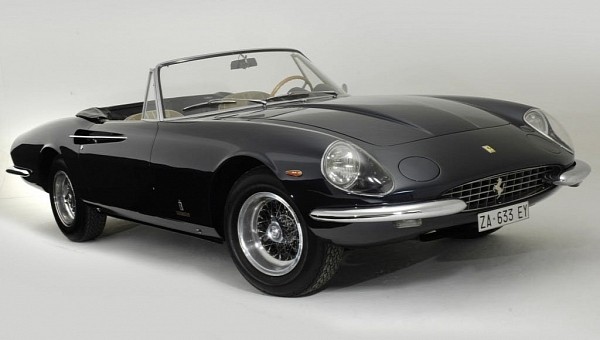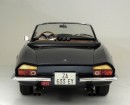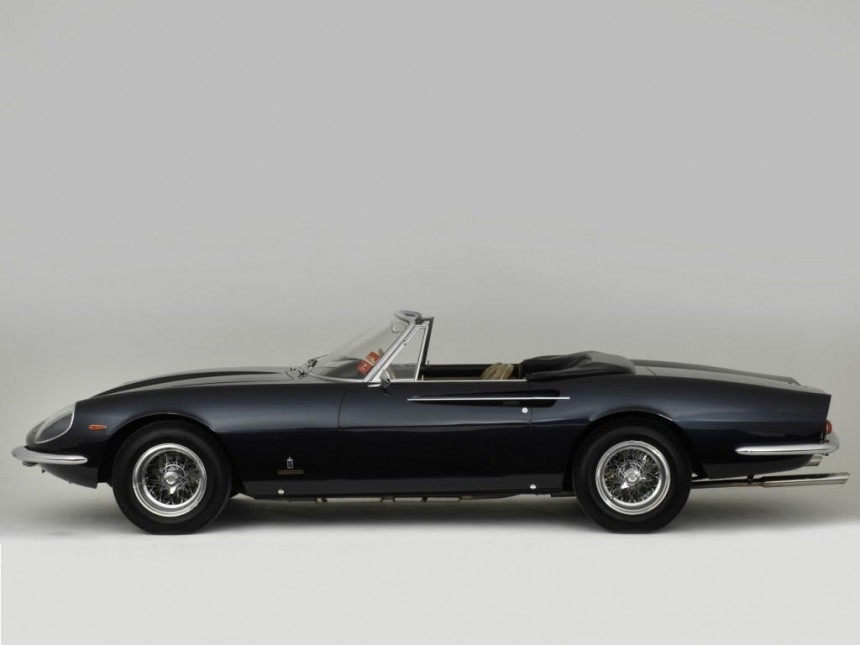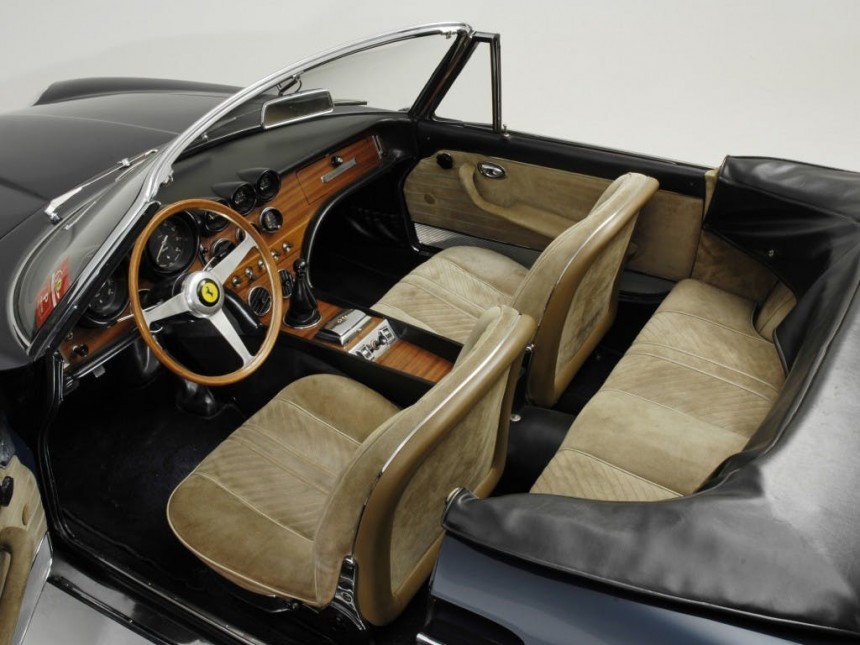Revived by the hard-topped convertible that Ferrari introduced back in 2008, the California nameplate was first used on the 250 series for the long- and short-wheelbase versions of an ultra-collectible roadster. This moniker carried over to the 365 series, namely the 365 California that is considered a member of the Ferrari America family of grand tourers.
Styled by Tom Tjaarda during his tenure at Pininfarina, a period when the American designer also penned the gorgeous-looking Corvette Rondine, the 365 California replaced the 500 Superfast at the 1966 edition of the Geneva Motor Show. A low-volume affair like all members of the Ferrari America family, this car used the same chassis as its predecessor. Wickedly expensive when it was brand-spanking new, the rarest variant of the 365 series boasts a steel chassis that spans 2,650 millimeters between its axles.
Double wishbones up front made it handle pretty well for an open-top vehicle by the standards of that era. The rear end integrates a radius-arm live rear axle. Telescopic shock absorbers further need to be mentioned, along with an anti-roll bar up front. Ferrari built the prototype of the 365 California on the steel chassis of the 330 GT, and subsequent units were twinned with the 500 Superfast. Codenamed Tipo 571 and Tipo 598, these platforms are vastly similar, save for the stronger engine mounting points.
What engine, you might be asking? As expected of the range-topping convertible from the Prancing Horse of Maranello, the 365 California used the Italian automaker’s range-topping V12 engine. Developed by Gioacchino Colombo, the 4.4-liter mill features a 60-degree angle between the cylinder banks, wet-sump lubrication, a SOHC valvetrain with two valves per cylinder, as well as single plug ignition with two ignition coils.
Codenamed Tipo 217 B, the free-breathing motor isn’t as large or as powerful as the powerplant hiding under the hood of the 500 Superfast. Developed to be slightly more comfortable than its predecessor, the 365 California rocks 315 horsepower at 6,400 revolutions per minute and 268 pound-foot (make that 363 Nm) of torque at 5,000 revolutions per minute.
The most powerful engine used in road-going Ferraris back then, the 4.4-liter mill in the 365 California features a 4-millimeter increase in bore from the 330 series. Both 365 and 330 designate the approximate displacement of each cylinder, which results in 4,380 and 3,960 cubic centimeters when multiplied by twelve. The 217 B was set up for a compression ratio of 8.8:1 in conjunction with three carbs from Fabbrica Italiana Carburatori Weber.
Gifted with an 81-millimeter bore and 71-millimeter stroke, this lump was exclusively connected to a five-speed manual transmission. Shared with the 330 series, the row-your-own gearbox is complemented by a limited-slip differential supplied by ZF. Tipping the scales at 1,320 kilograms, which converts to approximately 2,910 pounds, the 365 California is much obliged to hit 245 kilometers per hour (make that 152 miles per hour) on full song.
A little over six clicks are needed to reach 100 kilometers per hour (62 miles per hour), an impressive time for a grand tourer from the ‘60s. Even though we’re talking about a high-end convertible from the best name in the biz, the Prancing Horse of Maranello did not offer a lot of standard equipment. Air conditioning and seatbelts, for example, were optional. A fuel gauge, the ammeter, and a clock are normally mounted in the middle of the teak-dressed dashboard, but if the radio is specified, the clock is yanked out of its place, with the remaining gauges relocated on either side of the radio.
The beautifully-finished teak is joined by leather upholstery and some black vinyl for the transmission tunnel, armrests, and the top of the dashboard. The three-spoke steering wheel brings the point home with a wooden rim. It frames the speedometer and tachometer. To its right, you will find three gauges for the water temperature, oil pressure, and oil temperature.
Even though Ferrari cheaped out on the air conditioning, seatbelts, and radio, electric windows were standard. A 2+2 rather than a strict two-seat convertible, the 365 California may seem a little weird when admired head on. Flanked by covered headlights, the circular panels of the pop-up light pods make it hard for this Fezza to be confused with anything else. With the notable exception of the hood and flat-ish trunk lid, steel was used for the rest of the body shell. The said panels are constructed from aluminum.
Fake side intakes are featured as well, together with a larger-than-life rear deck that sports the Prancing Horse logo and California lettering just below it. Wild-looking taillights were used, each integrating three domed lenses mounted on a red panel, plus an amber reflector just above the red panel.
Bodied in Grugliasco, the 365 California shipped with 15- by 7-inch wire wheels from Borrani. As expected of a 1960s gran turismo, Pirelli rubber shoes were also employed. Stopping power comes courtesy of disc brakes, power steering was standard, and the rather thirsty V12 up front is connected to a fuel tank with a capacity of 112 liters (29.6 U.S. gallons).
365 California production came to a screeching halt in 1967 after the 14th example of the breed – chassis number 10369 – was finished. Famous owners include Rockefeller heiress Margaret Strong de Cuevas de Larrain (9127) and Haribo owner Hans Riegel (10155). Ramfis Trujillo, the son of Dominican Republic dictator Rafael Trujillo, owned chassis number 9615.
Double wishbones up front made it handle pretty well for an open-top vehicle by the standards of that era. The rear end integrates a radius-arm live rear axle. Telescopic shock absorbers further need to be mentioned, along with an anti-roll bar up front. Ferrari built the prototype of the 365 California on the steel chassis of the 330 GT, and subsequent units were twinned with the 500 Superfast. Codenamed Tipo 571 and Tipo 598, these platforms are vastly similar, save for the stronger engine mounting points.
What engine, you might be asking? As expected of the range-topping convertible from the Prancing Horse of Maranello, the 365 California used the Italian automaker’s range-topping V12 engine. Developed by Gioacchino Colombo, the 4.4-liter mill features a 60-degree angle between the cylinder banks, wet-sump lubrication, a SOHC valvetrain with two valves per cylinder, as well as single plug ignition with two ignition coils.
Codenamed Tipo 217 B, the free-breathing motor isn’t as large or as powerful as the powerplant hiding under the hood of the 500 Superfast. Developed to be slightly more comfortable than its predecessor, the 365 California rocks 315 horsepower at 6,400 revolutions per minute and 268 pound-foot (make that 363 Nm) of torque at 5,000 revolutions per minute.
Gifted with an 81-millimeter bore and 71-millimeter stroke, this lump was exclusively connected to a five-speed manual transmission. Shared with the 330 series, the row-your-own gearbox is complemented by a limited-slip differential supplied by ZF. Tipping the scales at 1,320 kilograms, which converts to approximately 2,910 pounds, the 365 California is much obliged to hit 245 kilometers per hour (make that 152 miles per hour) on full song.
A little over six clicks are needed to reach 100 kilometers per hour (62 miles per hour), an impressive time for a grand tourer from the ‘60s. Even though we’re talking about a high-end convertible from the best name in the biz, the Prancing Horse of Maranello did not offer a lot of standard equipment. Air conditioning and seatbelts, for example, were optional. A fuel gauge, the ammeter, and a clock are normally mounted in the middle of the teak-dressed dashboard, but if the radio is specified, the clock is yanked out of its place, with the remaining gauges relocated on either side of the radio.
The beautifully-finished teak is joined by leather upholstery and some black vinyl for the transmission tunnel, armrests, and the top of the dashboard. The three-spoke steering wheel brings the point home with a wooden rim. It frames the speedometer and tachometer. To its right, you will find three gauges for the water temperature, oil pressure, and oil temperature.
Fake side intakes are featured as well, together with a larger-than-life rear deck that sports the Prancing Horse logo and California lettering just below it. Wild-looking taillights were used, each integrating three domed lenses mounted on a red panel, plus an amber reflector just above the red panel.
Bodied in Grugliasco, the 365 California shipped with 15- by 7-inch wire wheels from Borrani. As expected of a 1960s gran turismo, Pirelli rubber shoes were also employed. Stopping power comes courtesy of disc brakes, power steering was standard, and the rather thirsty V12 up front is connected to a fuel tank with a capacity of 112 liters (29.6 U.S. gallons).
365 California production came to a screeching halt in 1967 after the 14th example of the breed – chassis number 10369 – was finished. Famous owners include Rockefeller heiress Margaret Strong de Cuevas de Larrain (9127) and Haribo owner Hans Riegel (10155). Ramfis Trujillo, the son of Dominican Republic dictator Rafael Trujillo, owned chassis number 9615.













